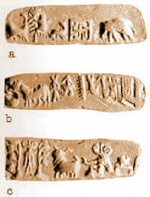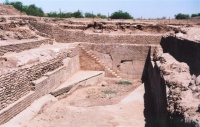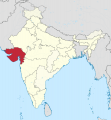Dholavira
Da Ufopedia.
(→Galleria immagini) |
(→Galleria immagini) |
||
| (Una revisione intermedia non mostrata.) | |||
| Riga 64: | Riga 64: | ||
Immagine:Map_GujDist_Kuchchh.png | Immagine:Map_GujDist_Kuchchh.png | ||
Immagine:Gujarat_in_India_28disputed_hatched29_svg.png | Immagine:Gujarat_in_India_28disputed_hatched29_svg.png | ||
| - | Immagine: | + | Immagine:Seal_of_Gujarat.jpg |
Immagine:Flag of India.svg.png | Immagine:Flag of India.svg.png | ||
Immagine:Flag of the United Nations svg.png | Immagine:Flag of the United Nations svg.png | ||
Versione attuale delle 11:34, 4 lug 2013
| Questa voce ha bisogno di essere tradotta. |
Dholavira, an ancient metropolitan city, and locally known as Kotada Timba Prachin Mahanagar Dholavira, is one of the largest and most prominent archaeological sites in India, belonging to the Indus Valley Civilization. It is located on the Khadir island in the Kachchh district of Gujarat, India which is surrounded by water in the monsoon season. The site was occupied from about 2900 BCE for about a millennium, declining slowly after about 2100 BCE; it was briefly abandoned, then villagers reoccupied the area of its ruins until about 1450.
Indice |
Chronology of Dholavira
R.S. Bisht, the director of the Dholavira excavations, has defined following seven stages of occupation, at the site[1]:
- Stage I Early Harappan - Mature Harappan Transition A 2650-2550 BCE
- Stage II Early Harappan - Mature Harappan Transition B 2550-2500 BCE
- Stage III Mature Harappan A 2500-2200 BCE
- Stage IV Mature Harappan B 2200-2000 BCE
- Stage V Mature Harappan C 2000-1900 BCE
- Period of desertion 1900-1850 BCE
- Stage VI Posturban Harappan A 1850-1750 BCE
- Period of desertion 1750-1650 BCE
- Stage VII Posturban Harappan B 1650-1450 BCE
Excavations
The ancient site at Dholavira (Template:Coord), is flanked by two storm water channels; the Mansar in the north, and the Manhar in the south. The site, discovered in 1967-8 by J.P. Joshi, is the fifth largest Harappan site in the Indian subcontinent, and has been under excavation almost continuously since 1990 by the Archaeological Survey of India.
Seven such urban centers have been discovered: Harappa, Mohenjo Daro, Ganeriwala in modern day Pakistan and Rakhigarhi, Kalibangan, Dholavira and Lothal in modern day India.
Excavation was initiated in 1989 by the Archaeological Survey of India under the direction of Dr. R. S. Bisht. The excavation brought to light the sophisticated urban planning and architecture, and unearthed large numbers of antiquities such as seals, beads, animal bones, gold, silver, terracotta ornaments and vessels linked to Mesopotamia. Archaeologists believe that Dholavira was an important centre of trade between settlements in south Gujarat, Sindh and Punjab and Western Asia.
Architecture and material culture
Estimated to be older than the port-city of Lothal, the city of Dholavira has a rectangular shape and organization, and is spread over 100 hectares. The area measures 771.10 metres in length, and 616.85 metres in width. Like Harappa and Mohenjo-Daro (Pakistan), the city is composed to a pre-existing geometrical plan, of three divisions - the citadel, the middle town and the lower town. The acropolis and the middle town had been further furnished with their own defence-work, gateways, built-up areas, street system, wells and large open spaces. The acropolis is the most carefully guarded as well as impressive and imposing complex in the city of which it appropriates the major portion of the southwestern zone. The towering "castle" stands majestically in fair insulation and defended by double ramparts. Next to this stands a place called 'bailey' where important officials lived. The city within the general fortification accounts for 48 hectares. There are extensive structure-bearing areas though outside yet intimately integral to the fortified settlement. Beyond the walls, yet another settlement has been found. The most striking feature of the city is that all of its buildings, at least in their present state of preservation, are built out of stone, whereas most other Harappan sites, including Harappa itself and Mohenjo-Daro, are almost exclusively built out of brick.
Reservoirs
One of the unique features of Dholavira is the sophisticated water conservation system of channels and reservoirs, the earliest found anywhere in the world and completely built out of stone, of which three are exposed. They were used for storing the fresh water brought by rains or to store the water diverted from a nearby rivulet. This probably came in wake of the desert climate and conditions of Kutch, where several years may pass without rainfall.
The Dholaviraites created sixteen or more reservoirs of varying size during Stage III. Some of these took advantage of the slope of the ground within the large settlement, a drop of 13 m from northeast to northwest. Other reservoirs were excavted, some into living rock. Recent work has revealed two large reservoirs, one to the east of the castle and one to its south, near the Annexe.[2]
Reservoirs are cut through stones vertically. They are about 7 meter deep and 79 meter long. Reservoirs skirted the city while citadel and bath are centrally located on raised ground [3]. A large well with a stone-cut trough to connect the drain meant for conducting water to a storage tank also found.[3] Bathing tank had steps descending inwards.
Sign board
One of the most significant discoveries at Dholavira was made in one of the side rooms of the northern gateway of the city. The Harappans had arranged and set pieces of gypsum (a kind of mineral) to form ten large letters on a big wooden board. At some point of time the board fell down flat on its face. The wood decayed, but the arrangement of the letters survived. The letters of the signboard are comparable to large bricks that were used in nearby wall. Each sign is about 37 cm high and the board on which letters were inscribed was about 3 meter long.[4] These signs might have been logographic.
Other structures and objects
A huge circular structure, believed to be grave or memorial is found. However no skeleton or human remains found under structure. The circular structure is built with ten radial walls of mud bricks in a shape of spoked wheel.[3] A soft sandstone sculpture of a male with phallus erectus but head and feet below ankle truncated was found in the passage way of the eastern gate.[3] Also many funerary structures are found, however except one they were devoid of skeletons. Also many pottery pieces, terracotta seals, bangles, rings, beads and intaglio engraving found.
Language and calligraphy

It is not known which language the Harappan people spoke, and their script cannot be read. It had about 400 basic signs, with many variations. The signs may have stood both for words and for syllables. The direction of the writing was generally from right to left. Most of the inscriptions are found on seals (mostly made out of stone) and sealings (pieces of clay on which the seal was pressed down to leave its impression). Some inscriptions are also found on copper tablets, bronze implements, and small objects made of terracotta, stone and faience. The seals may have been used in trade and also for official administrative work. A lot of inscribed material was found at Mohenjo Daro.
How to reach Dholavira
- By Air - The nearest airport is in Gandhidham about 250 km away, where a daily flight between Mumbai and Gandhidham is available. Another airport close to Dholavira is Bhuj airport about 300 km away, where daily two flights between Bhuj and Mumbai are available.
- By Rail - Samakhyali (160 km) on the Palanpur-Gandhidham BG line.
- By Road - from Ahmedabad
Roads are usable until Rapar town; from there the road to Dholavira is two lanes. The best time to visit is November to March.
Galleria immagini
References
- ↑ Possehl, Gregory L. (2004). The Indus Civilization: A contemporary perspective, New Delhi: Vistaar Publications, ISBN 81-7829-291-2, p.67.
- ↑ Possehl, Gregory L. (2004). The Indus Civilization: A contemporary perspective, New Delhi: Vistaar Publications, ISBN 81-7829-291-2, p.69.
- ↑ 3,0 3,1 3,2 3,3 Template:Cite news
- ↑ Template:Cite journal
External links
- Excavations at Dholavira in Archaeological Survey of India website.
- Computer graphics reconstruction of Dholavira
- The Old World - Dholavira
- Dholavira (Gujarat, India)
- Dholavira excavations throw light on Harappan civilisation, United News of India 1997
- Nisid Hajari, "India's Salt Lake Cities", in Time Magazine 1 September 1997
- World Heritage Site, All Tentative Sites, Here is an overview of all Tentative list, last updated June, 2006.
- World Heritage, Tentative Lists, State : India.
- Dholavira: a Harappan City, Gujarat, Disstt, Kachchh - UNESCO World






